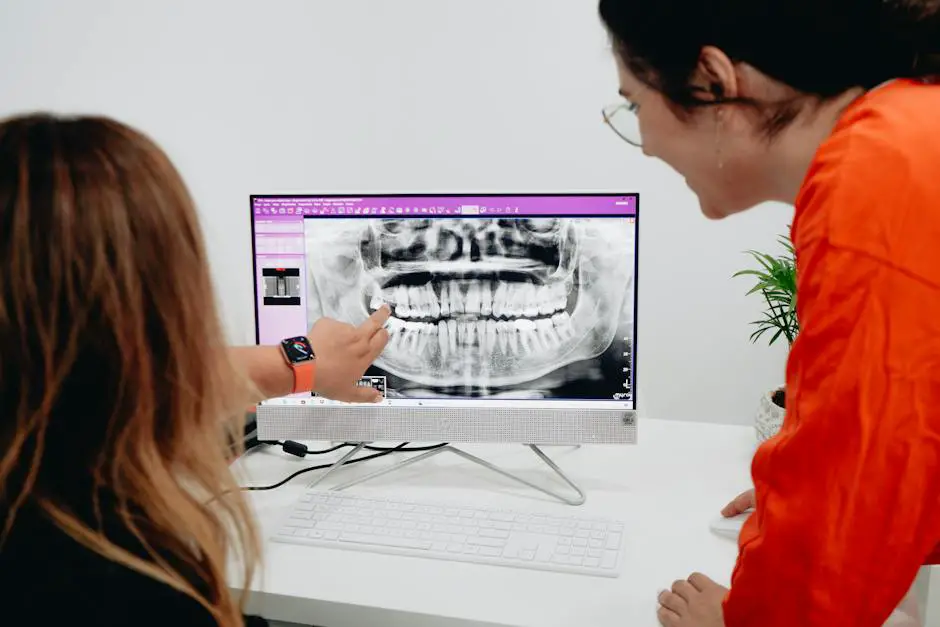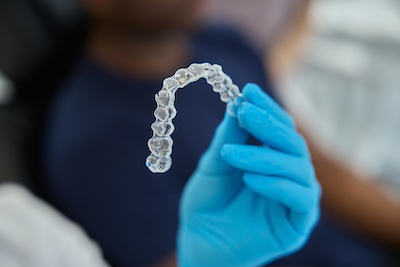An underbite, characterized by the lower teeth protruding beyond the upper teeth, can pose not just cosmetic concerns but also potential issues with speech, eating, and oral health. As dental technology advances, individuals facing this condition have more options than ever, including the discreet choice of invisible braces.
These clear aligners offer a less noticeable and often more convenient treatment compared to traditional metal orthodontics. Bridging the gap between aesthetic aspirations and dental health, and understanding how invisible braces can tackle an underbite is the first step towards a transformed smile and restored confidence.
Understanding Underbite and Invisible Braces
An underbite, or prognathism, is a prominent dental malocclusion characterized by the anterior projection of the mandibular teeth beyond the maxillary teeth. This condition poses functional, aesthetic, and psychosocial challenges to affected individuals.
In recent years, invisible braces—commercially known as clear aligners—have emerged as an efficacious modality for the orthodontic management of underbites. This article delineates the clinical presentation of underbites and elucidates the mechanism by which clear aligner therapy rectifies this malalignment.
Within the realm of orthodontic anomalies, an underbite holds a position of clinical concern due to its impact on mastication, speech, and facial morphology. The genesis of this condition can often be traced to genetic etiologies or developmental discrepancies between jaw sizes. Timely correction is essential not only for the restoration of function but also for the improvement of the patient’s self-esteem and overall oral health.
Clear Aligner Therapy as a Treatment Modality
Clear aligner therapy represents an innovation in orthodontic treatment, which offers an aesthetically appealing alternative to traditional braces. These transparent, removable orthodontic devices are custom-fabricated using advanced computer modeling to fit snugly over the teeth and exert controlled forces that incrementally guide dentition into alignment.
The Mechanism of Underbite Correction
Initial Assessment
The journey to correct an underbite with clear aligners commences with a comprehensive dental assessment, including diagnostic imaging and impressions of the dental arches, to ascertain the underbite’s severity and complexity.
Strategic Planning
Following the analysis of diagnostic data, orthodontists devise a treatment plan. This involves the sequencing of tooth movements and the fabrication of a series of aligners that progressively accomplish the shifts necessary for bite correction.
Gradual Mandibular Repositioning
Clear aligners apply consistent pressure on the mandibular teeth, guiding them toward a more retrusive position. Concurrently, the maxillary teeth may be advanced, fostering an improved intercuspation and occlusal relationship.
Supplementary Techniques
Adjunctive strategies, such as interproximal reduction or the incorporation of attachments, can enhance aligner efficacy by providing additional grip and precise directional forces.
Compliance and Monitoring
Patient adherence to wearing the aligners for the recommended duration daily—typically 22 hours—is pivotal to treatment success. Periodic evaluations and adjustments ensure ongoing progress and address any emerging challenges.
Retention Phase
Upon reaching the desired alignment, retainers are mandated to maintain the corrected position of the teeth, forestalling relapse.
Invisible braces, via clear aligner therapy, provide a viable and increasingly preferred methodology for ameliorating underbites. This discreet, patient-friendly approach is reinforced by technological advancements and professional expertise, permitting a harmonious occlusion to be attained with minimal intrusion into daily life.
As research and clinical practice continue to refine and validate such techniques, clear aligners are sure to maintain their position at the forefront of orthodontic solutions.
Consultation with Orthodontist
Orthodontic consultations serve as the cornerstone for devising an effective treatment plan for underbite correction using invisible braces. A thorough evaluation by an orthodontist is imperative to ascertain the complexity and uniqueness of each case, thereby ensuring a personalized treatment approach.
During the consultation, the practitioner conducts a comprehensive intraoral examination complemented by radiographic analysis and digital scanning. This allows for a meticulous assessment of the skeletal and dental components contributing to the underbite. Such diagnostic tools enable the orthodontist to discern the severity of the malocclusion—whether it is predominantly dental, skeletal, or a combination of both.
Evaluating Periodontal Health
Furthermore, an orthodontic consultation provides a platform for evaluating the patient’s periodontal health. Healthy gums are an essential foundation for orthodontic maneuvers as clear aligner therapy relies on the ability to effectuate dental movements within the alveolar bone. Any periodontal disease must be addressed before commencing treatment to prevent exacerbation of the existing condition.
Review Dental History
Another pivotal aspect covered during the consultation pertains to the patient’s dental history and the presence of any restorative work that might influence the treatment plan. Crowns, bridges, and dental implants present specific challenges and require individualized strategies for inclusion in the clear aligner protocol.
Additionally, an orthodontic consultation avails the opportunity to discuss treatment duration, frequency of aligner changes, and anticipated follow-up visits, ensuring patient understanding and setting realistic expectations. This also includes detailing the necessity for aligner wear compliance, typically on the order of 20-22 hours per day, which is crucial for successful outcomes.
In cases where an underbite is coupled with other dental concerns such as crowding, spacing, or crossbite, the consultation allows for the development of a comprehensive and multidisciplinary treatment strategy. Such complexities often necessitate a phased approach, combining various orthodontic techniques to achieve the desired result.
Provide Information
It should also be emphasized that the consultation enables the orthodontist to furnish the patient with information regarding potential risks and limitations of clear aligner therapy in underbite treatment.
While invisible braces offer an aesthetic and comfortable alternative to traditional orthodontic appliances, they may not be the optimal choice for every patient. Discussing these nuances ensures that the patient makes an informed decision.
Establishing Rapport
Finally, the orthodontic consultation is crucial for establishing a rapport between the practitioner and the patient, which is fundamental for fostering a collaborative treatment atmosphere. Open communication is essential for addressing concerns and modifying the treatment as it progresses.
In sum, the orthodontic consultation is an indispensable step, designed to ensure that each patient receives a tailor-made treatment plan, considering their specific dental anatomy and needs. Without this critical foundation, the application of clear aligner therapy would lack the precision and customization necessary to correct an underbite effectively.

Invisible Braces Treatment Plan
Creating a personalized treatment plan for an underbite using invisible braces is a sophisticated and multi-faceted process that demands a deep understanding of dental anatomy, orthodontic biomechanics, and individual patient variables.
The development of such a treatment plan begins after an exhaustive orthodontic evaluation, which includes the steps previously delineated.
Design a Tailored Treatment Strategy
To design a tailored treatment strategy, the selection of the appropriate invisible braces system is essential. The market offers various brands, each with its nuances in design and function.
The chosen system must be adept at generating the necessary forces to facilitate underbite correction while accommodating the individual’s specific orthodontic needs.
Create Personalized 3D Models
Following the selection of an invisible braces system, a thorough digital analysis is undertaken. This involves the creation of personalized 3D dental models through high-resolution imaging and scanning technologies.
These models afford a virtual representation of the teeth and jaw, facilitating precise simulation of tooth movements. The exact pathways by which the teeth will shift into their desired alignment are meticulously planned.
This planning includes the determination of the sequence and degree of each movement, thereby customizing the series of aligners to effectuate the transformation.
The patient’s digital model is employed to engineer a set of custom-fabricated aligners. Each aligner is worn for a designated period, typically one to two weeks, before progressing to the next in the series, slowly coaxing the teeth into a more favorable position.
With underbites, the focus is often on shifting the lower teeth backward and/or bringing the upper teeth forward to achieve an optimal bite alignment.
Establish Interdisciplinary Collaboration
Interdisciplinary collaboration with other dental specialists may be warranted, particularly in complex cases where an underbite is compounded by other craniofacial discrepancies.
Adjunctive therapies, such as maxillofacial surgery or restorative dental procedures, might be integrated into the treatment protocol to ensure a comprehensive approach.
Monitor Progress
The rate of progress is closely monitored through periodic check-ins with the orthodontic practitioner. Adjustments to the treatment plan are made as necessary, based on the patient’s response to the aligners and ongoing oral health status.
Emphasis on open communication channels between the patient and the orthodontist facilitates the identification and timely rectification of any noncompliance issues or unexpected treatment responses.
Throughout treatment with invisible braces, the surrounding gingival and periodontal conditions must be preserved, demanding a rigorous oral hygiene protocol prescribed by the practitioner. This aspect of patient education underscores the symbiotic relationship between orthodontic correction and overall dental health.
Design a Retainer
Finally, upon reaching the desired correction, the production of a retainer is indicative of the transition into the maintenance phase. The retainer is custom-designed from the final alignment model to ensure the stability of the correction achieved. Wear of this device is typically lifelong during nocturnal hours to prevent relapse.
In summary, the intricate process of devising a personalized treatment plan for an underbite with invisible braces blends state-of-the-art technology with specialized orthodontic expertise.
By adhering to a meticulously crafted blueprint for tooth movement alongside diligent observation and patient collaboration, successful outcomes can be attained, culminating in improved function, aesthetically pleasing results, and enhanced psychological well-being for the patient.
Using Invisible Braces to Fix Your Underbite
Embarking on the journey to correct an underbite with invisible braces marks the beginning of not only enhancing one’s dental alignment but also improving overall oral functionality. It’s a path that requires commitment and patience but promises transformative results.
With a tailored treatment plan from a skilled orthodontist and the latest advancements in orthodontic technology at your disposal, achieving a harmonious bite and a more balanced smile is a tangible goal.
The invisible braces experience is a testament to the power of modern orthodontics: a discreet and dynamic approach to achieving oral health and aesthetic harmony.










